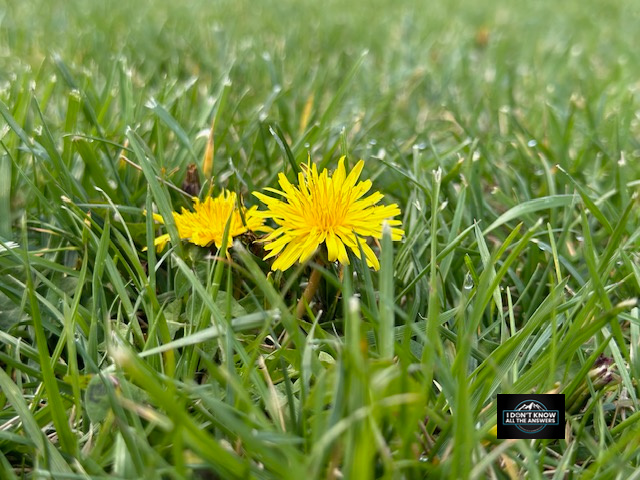We have a large Lawn area on the new property, and I noticed that we have many cute little yellow dandelions poking their little head up through the grass. I think they’re adorable, but Jim says they are a weed. What are they? I’ve been fascinated by dandelions and their journey through time and healing.
Did you know that dandelions have a long history of medicinal use? They were used by the ancient Greeks, Egyptians, and Romans for various ailments such as liver problems, digestive issues, and even skin conditions. The name “dandelion” comes from the French word “dent-de-lion,” which means lion’s tooth, referring to the plant’s jagged leaves.
But it’s not just their past uses that make dandelions interesting. These little yellow flowers also have a unique way of spreading their seeds. When the flower matures, it turns into a white puffball of tiny seeds attached to feathery stock.
This humble little flower, often branded as the interloper of manicured lawns, bears a history as rich and profound as its roots, thrust deep into the earth.
Once upon a time, long before our relentless pursuit of the pristine American lawn, the dandelion was revered for its medicinal virtues and botanical charm. From the windswept shores of ancient Egypt to the verdant hills of Rome, these golden blooms were cherished for more than their splendor—they were a beacon of health and wellness.
To speak of dandelions is to unravel a narrative entwined with our evolution. The first pilgrims proudly carried them across tumultuous seas—not as mere stowaways but as valued allies for their remedy-rich potential to treat ailments from warts to the dread of all maladies, the plague. The very sight of these floral beacons harkened to the warmth and safety of home, a familiar solace in an unknown land.
Their significance stretched far and wide. In Japan, people formed societies that elevated the beauty of the dandelion to an art, cultivating varieties that would make even the most distinguished gardeners pause and marvel. But beyond aesthetic pleasure, this plant’s true legacy was its power to heal and nourish.
Imagine, if you will, a world devoid of multivitamins, where each bite of food counted for sustenance and safeguarding against invisible afflictions. Mighty dandelions, packed with more vitamin A than spinach and surpassing tomatoes in vitamin C, emerged as silent saviors. In an age haunted by scurvy and invisible deficiencies, they were a green and growing lifeline, a natural elixir flourishing in the unlikeliest places.
Those lion-toothed leaves knew no bounds, unfurling across fields and breaking through concrete with a healer’s touch. Their secret? A resilience that whispers of nature’s indomitable spirit—a plant that, once settled in, becomes an enduring tenant. Such tenacity poses vexing challenges to modern gardeners. Yet, that persistence underlines the essence of survival, a salute to life’s unflagging will.
And who could foresee that the humble dandelion would grace our tables not just in salads but as the main attraction in sophisticated dishes, washed down with wines and teas crafted from its very essence? Their surprising worth in the marketplace, where they command prices rivaling luxury delicacies, is a testament to their versatile allure.
But it has not all been a tale of adoration and grandeur. The dawn of the suburban dream cast dandelions in a new, less favorable light—as invaders to our velvety green sanctuaries. Yet, what if there was beauty in coexistence, a symbiosis where their roots untangled our soil and drew forth calcium, sharing their bounty with less dynamic neighbors? Nonetheless, we wage war with chemicals—concoctions that, while vanquishing unwelcome guests, also silence the chorus of birds and undermine nature’s delicate balance. Yet, hope glimmers with the knowledge that alternatives exist and that harmony is possible through understanding the secret dance of light and shade, life and coexistence.
The dandelion is not merely a flower or a weed; it reflects our intertwining with the earth, our histories, our need for healing, and our pursuit of beauty. The tales it holds are of resilience, bounty, and balance—a symphony performed on a quiet stage, with blades of grass as the seats, awaiting an audience willing to listen, learn, and grow.
Next time you spy a dandelion, I invite you to see not a weed but a friend—an emblem of a bygone era that bears secrets and stories, whispering of a time when to bloom was to heal and to exist was to nourish both body and soul.
Note: This blog post’s main picture is a photo of a dandelion, one of many on my lawn. I think they’re so cute!
Reference:
Dandelion root tea side effects. http://www.whnuckolsconsulting.com/site/u0hbtny.php?tag=dandelion-root-tea-side-effects-2f231b
Thank you for reading this blog post. If you have any questions or comments, please leave them in the Comments section below.
Copyright © 2019. I Don’t Know All The Answers, Nikki Mastro.
All of my photographs and documents are Copyrighted.
No part of this website, including text, photographs, and documents, may be reproduced, stored in a retrieval system, or transmitted in any form or by any means without written permission from the copyright holder. All unauthorized use is strictly prohibited. If you choose to copy or share any information from my site, you must provide a link to the source. I appreciate your cooperation.
For further information concerning “I Don’t Know All The Answers.”
– Blog: https://www.idontknowalltheanswers.com
– Facebook: https://www.facebook.com/Nikki.L.Mastro
– Instagram: https://www.instagram.com/i_dont_know_all_the_answers/
– Linkedin: https://www.linkedin.com/in/nikki-mastro-05455a3a/
– Youtube Channel: https://www.youtube.com/@idontknowalltheanswers1954

